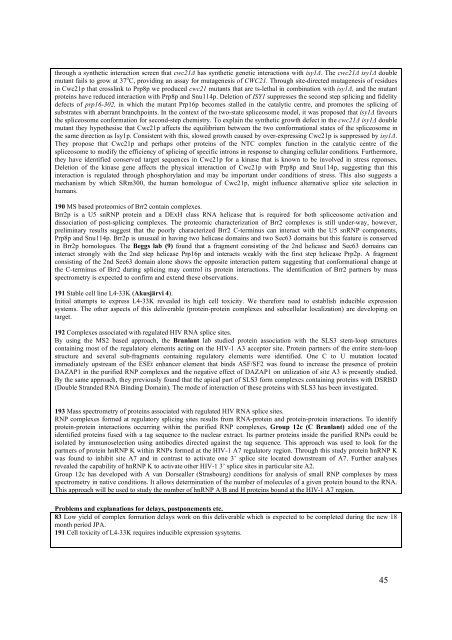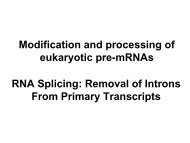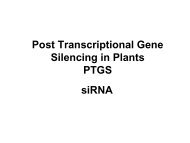You also want an ePaper? Increase the reach of your titles
YUMPU automatically turns print PDFs into web optimized ePapers that Google loves.
through a synthetic interaction screen that cwc21Δ has synthetic genetic interactions with isy1Δ. The cwc21Δ isy1Δ doublemutant fails to grow at 37 o C, providing an assay for mutagenesis of CWC21. Through site-directed mutagenesis of residuesin Cwc21p that crosslink to Prp8p we produced cwc21 mutants that are ts-lethal in combination with isy1Δ, and the mutantproteins have reduced interaction with Prp8p and Snu114p. Deletion of ISY1 suppresses the second step splicing and fidelitydefects of prp16-302, in which the mutant Prp16p becomes stalled in the catalytic centre, and promotes the splicing ofsubstrates with aberrant branchpoints. In the context of the two-state spliceosome model, it was proposed that isy1Δ favoursthe spliceosome conformation for second-step chemistry. To explain the synthetic growth defect in the cwc21Δ isy1Δ doublemutant they hypothesise that Cwc21p affects the equilibrium between the two conformational states of the spliceosome inthe same direction as Isy1p. Consistent with this, slowed growth caused by over-expressing Cwc21p is suppressed by isy1Δ.They propose that Cwc21p and perhaps other proteins of the NTC complex function in the catalytic centre of thespliceosome to modify the efficiency of splicing of specific introns in response to changing cellular conditions. Furthermore,they have identified conserved target sequences in Cwc21p for a kinase that is known to be involved in stress reponses.Deletion of the kinase gene affects the physical interaction of Cwc21p with Prp8p and Snu114p, suggesting that thisinteraction is regulated through phosphorylation and may be important under conditions of stress. This also suggests amechanism by which SRm300, the human homologue of Cwc21p, might influence alternative splice site selection inhumans.190 MS based proteomics of Brr2 contain complexes.Brr2p is a U5 snRNP protein and a DExH class RNA helicase that is required for both spliceosome activation anddissociation of post-splicing complexes. The proteomic characterization of Brr2 complexes is still under-way, however,preliminary results suggest that the poorly characterized Brr2 C-terminus can interact with the U5 snRNP components,Prp8p and Snu114p. Brr2p is unusual in having two helicase domains and two Sec63 domains but this feature is conservedin Brr2p homologues. The Beggs lab (9) found that a fragment consisting of the 2nd helicase and Sec63 domains caninteract strongly with the 2nd step helicase Prp16p and interacts weakly with the first step helicase Prp2p. A fragmentconsisting of the 2nd Sec63 domain alone shows the opposite interaction pattern suggesting that conformational change atthe C-terminus of Brr2 during splicing may control its protein interactions. The identification of Brr2 partners by massspectrometry is expected to confirm and extend these observations.191 Stable cell line L4-33K (Akusjärvi 4).Initial attempts to express L4-33K revealed its high cell toxicity. We therefore need to establish inducible expressionsystems. The other aspects of this deliverable (protein-protein complexes and subcellular localization) are developing ontarget.192 Complexes associated with regulated HIV RNA splice sites.By using the MS2 based approach, the Branlant lab studied protein association with the SLS3 stem-loop structurescontaining most of the regulatory elements acting on the HIV-1 A3 acceptor site. Protein partners of the entire stem-loopstructure and several sub-fragments containing regulatory elements were identified. One C to U mutation locatedimmediately upstream of the ESEt enhancer element that binds ASF/SF2 was found to increase the presence of proteinDAZAP1 in the purified RNP complexes and the negative effect of DAZAP1 on utilization of site A3 is presently studied.By the same approach, they previously found that the apical part of SLS3 form complexes containing proteins with DSRBD(Double Stranded RNA Binding Domain). The mode of interaction of these proteins with SLS3 has been investigated.193 Mass spectrometry of proteins associated with regulated HIV RNA splice sites.RNP complexes formed at regulatory splicing sites results from RNA-protein and protein-protein interactions. To identifyprotein-protein interactions occurring within the purified RNP complexes, Group 12c (C Branlant) added one of theidentified proteins fused with a tag sequence to the nuclear extract. Its partner proteins inside the purified RNPs could beisolated by immunoselection using antibodies directed against the tag sequence. This approach was used to look for thepartners of protein hnRNP K within RNPs formed at the HIV-1 A7 regulatory region. Through this study protein hnRNP Kwas found to inhibit site A7 and in contrast to activate one 3’ splice site located downstream of A7. Further analysesrevealed the capability of hnRNP K to activate other HIV-1 3’ splice sites in particular site A2.Group 12c has developed with A van Dorsealler (Strasbourg) conditions for analysis of small RNP complexes by massspectrometry in native conditions. It allows determination of the number of molecules of a given protein bound to the RNA.This approach will be used to study the number of hnRNP A/B and H proteins bound at the HIV-1 A7 region.Problems and explanations for delays, postponements etc.83 Low yield of complex formation delays work on this deliverable which is expected to be completed during the new 18month period JPA.191 Cell toxicity of L4-33K requires inducible expression sysytems.45







